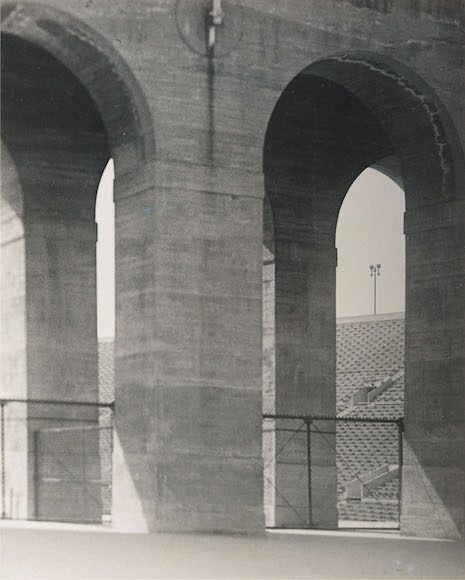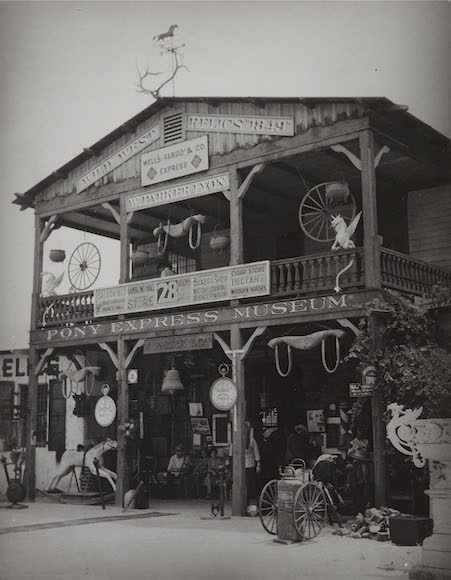
A l’Heure de l’observatoire—les amoureux, 1970
color offset lithograph on wove paper
edition of 150, 14 x 35.5 in. (35.6 x 90.2 cm)

Mathematical Object (Anthony), 1934-35
gelatin silver print
11.5 x 9.25 in. (29 x 23.5 cm)

Untitled (Los Angeles Memorial Coliseum), ca. 1941
gelatin silver print
9.75 x 7.75 in. (24.8 x 19.7 cm)

Untitled (Knotts Berry Farm, Buena Park), ca. 1940-49
gelatin silver print
10 x 7.75 in. (25.4 x 19.7 cm)

Untitled (Knotts Berry Farm, Buena Park), ca. 1940-49
gelatin silver print
9.9 x 7.4 in. (25 x 18.9 cm)
April – June, 2020
A l’Heure de l’observatoire—les amoureux, 1970 depicts Man Ray’s most famous painting, A l’Heure de l’observatoire—les amoureux, 1932-34: a pair of enormous female lips detached from a visage and floating mysteriously over the city of Paris. They were the lips of Lee Miller, Man Ray’s lover who left him just before he embarked upon the painting of this picture and, thus, historians have understood it to serve as his memorial to her or his personal purgative of loss. Whatever its motive, with this one image Man Ray has succeeded in capturing the essence of Surrealism: an image displaced from its natural environment and placed within a magical setting, while at the same time evoking the depiction of a dream.
Due to the ongoing situation with COVID-19, Baahng Gallery is postponing upcoming exhibitions and programs. In the meantime, we will be providing series of online exhibitions and announcements. For information about the exhibitions or the works, please contact us at inquiries@baahng.com
Biography
Painter, sculptor, photographer, filmmaker, draftsman…Man Ray has never limited himself to a single medium of artistic expression, tirelessly seeking new possibilities of creation or diversion of existing techniques. Considering art essentially as a game, he refused to attach himself to a determined style. Man Ray was born in 1980 in Philadelphia. In 1913, he discovered at the exhibition The Armory Show in New York European artists like Marcel Duchamp and Francis Picabia. With Marcel Duchamp he created and experimented with optical devices to study motion. He participated in the Dada movement in New york until 1921, when he left for France. As he arrived in Paris, Marcel Duchamp introduced him to the Parisian artistic scene. It was the beginning of an intense period of creation: photographs (fashion, portraits, art), exhibitions, films…In the interwar period Paris, Man Ray frequents all the greatest actors of creation, Dadaists, Surrealists, writers, filmmakers, fashion designers…In 1940, Man Ray had to leave France for the United States, where he realized major works like the Shakespearian paintings, etc. Man Ray returned to Paris in 1951, moved to rue Ferou where he painted, drew, wrote his memoirs and continued to use photographic processes. Thus begins the edition of his objects “Objects of my affection” first with Marcel Zerbib, then with Arturo Schwarz. Man Ray died on November 18, 1976 in Paris. He is buried in the Montparnasse cemetery.
…………………………………………. excerpt from Man Ray International Association
Mathematical Object (Anthony) is one of some twenty photographs taken by Man Ray in 1934-35 of mathematical models located in the Institut Poincaré in Paris. Twelve of the photographs were featured in a 1936 issue of the journal Cahiers d’Art devoted to the “object” and four were exhibited in MoMA’s exhibition the same year, Fantastic Art, Dada, Surrealism. The models were drawn to his attention by Max Ernst, who had discovered them and thought them exceptionally provocative, surreal shapes. The models were used to render complex mathematical formulae into three-dimensional form, but it was not their origin in mathematics that attracted the interests of Man Ray. “The formulas accompanying them meant nothing to me,” he later explained, “the forms themselves were as varied and authentic as any in nature” (Self-Portrait, 1963, p. 368). While living in Hollywood, California, in the 1940s, Man Ray used the photographs he had taken in the Institut Poincaré as the basis of a series of pictures that he grouped under the title “The Shakespearean Equations,” which, in true Dada and Surrealist fashion, had as little to do with Shakespeare as they did with equations. Man Ray retrieved the photographs he had printed in the 1930s on a trip back to Paris in 1947, and this example is believed to be among them. This particular print is often titled Antony, as we know that it was used as the basis for the figure of Anthony in his painting Antony and Cleopatra, 1948.
.
Related:
Categories: exhibitions
Tags: Man Ray
